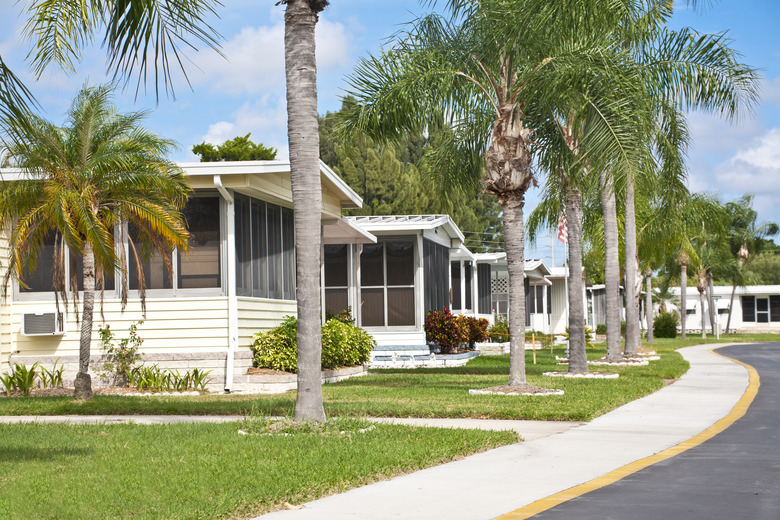The Differences In HVAC Units In Mobile Homes And Regular Housing
We may receive a commission on purchases made from links.
Old-fashioned mobile homes, also known as trailer homes, and modern manufactured homes are delivered to a home site. A single-wide home arrives in one piece, while double- and triple-wide homes are brought in sections and then assembled, unlike a traditionally built home that is constructed completely onsite. This requires a few differences in the way the HVAC unit of a mobile home is installed and designed, versus a manufactured or stick-built home.
Mobile Versus Manufactured Homes
Mobile Versus Manufactured Homes
Mobile homes are trailer homes manufactured prior to June 15, 1976, while manufactured homes are essentially prefabricated homes built after that date. In general, mobile homes are not attached to permanent foundations. Instead, they are supported on the trailer frame and wheels or concrete blocks, with a metal or vinyl skirting that hides the undercarriage.
Manufactured homes are usually attached to permanent foundations after being trucked to the site. They are not intended to be moved again. A manufactured home, like a mobile home, may be made up of one, two, three, or more sections that are attached onsite. The difference is that manufactured homes follow current U.S. Department of Housing and Urban Development (HUD) safety standards, which makes them as safe as stick-built homes.
HVAC Installation Processes
HVAC Installation Processes
The installation of an air conditioning or heating unit in a new manufactured home is somewhat similar to the process used in a site-built home. In general, the ductwork is installed while the unit is built in the factory. The actual HVAC system may be installed in the factory or onsite by a sub-contractor, like a stick-built home. An electrician might also connect the unit, making it possible that several different contractors or sub-contractors were involved when installing the HVAC system.
Small, Enclosed Furnaces
Small, Enclosed Furnaces
The most common furnace installed in an older mobile home is a forced air unit. This is because a mobile home does not have the extra crawl space or attic space for a different type of furnace to safely fit into. This unit sits in a small, enclosed furnace cabinet featuring a vented door. Keep the vents clear for optimum operation of the furnace or HVAC unit.
Manufactured homes feature central HVAC systems with traditional ducting, like a stick-built home, or ductless mini-split systems, which have an outdoor unit attached to the air handlers inside the home. One advantage of mini-split systems, which may also be installed in traditional homes, is that the temperature can be set for individual areas or rooms.
Adding Air Conditioning
Adding Air Conditioning
Retrofitting a new air conditioner or HVAC system in an older mobile home can be a challenge. Mobile homes may lack ductwork and floor or ceiling vents, making a window unit or portable air conditioner the only choice. Other homes feature ducts running to the furnace, in which case cooling coils can be installed inside the furnace cabinet itself. However, the old ducting may be smaller than today's standard sized ducting, requiring duct replacement or careful sizing of a compatible HVAC system manufactured specifically for mobile homes.
Manufactured homes, which can be ordered with an air conditioning unit at the time of purchase, can have a new unit added later or have the entire HVAC system replaced, just like a stick-built home. If the original thermostat or ducting is damaged, they will also require repairs or replacement.
Crossover Ducts and Mobile Homes
Crossover Ducts and Mobile Homes
Older mobile homes may feature crossover ducts, which are large flexible ducts that run under the house. These ducts transfer warm and cool area to level out the overall temperature in the house. Due to limited attic or ceiling space, HVAC installers run these ducts in the crawl space. Unfortunately, this leaves them susceptible to damage from water and rodents.
If your mobile home's heating or cooling vents are not putting out the amount of air that they used to, check the crossover ducts for leaks or disconnected sections. You may need new sections of ducting or aluminum tape to seal the connections between the ducts.
References
- HVACDirect.com: Stick Built vs. Manufactured Homes for HVAC Systems
- Conditioned Air Solutions: HVAC Systems for Manufactured and Mobile Homes
- ACE Plumbing, Heating & Air Conditioning FAQ: Air Conditioning for Manufactured Homes
- TRIAD Financial Services: How Manufactured Homes Differ From Mobile and Modular Homes
